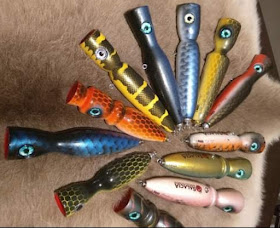 |
| VARIOUS DESIGNS: Kennedy showing the drawings of his collection of dagger grip designs. |
 | |
| ALL DONE: Kennedy with some of his finished products. |
Patience and time According to Kennedy, mainly Iban designs are carved on the casings and the work takes patience and time. “Very few people have the heart for this kind of work,” he said. At first, Kennedy paid scant attention to his exquisite carvings on the casings until friends and family members asked him who made them for him. “They couldn’t believe I did it because to them, only a master craftsman could produce beautiful carvings on wood.” As word got around, his orders started to pile up. But he is getting a bit worried about his expanding clientele as he is a part-time artisan and only does the carvings in his free time. “It’s only a hobby,” he said. He gets his ideas from books on Iban motifs before coming up with his own designs on a piece of paper and selecting the right tools for the carving process. “I taught myself everything about wood-carving and improvised some of my tools for better handling. I don’t consider myself a master craftsman. I do it as a pastime but I’m happy to say, it has helpd me regain my perspective after being a cancer patient.” Kennedy, an Iban from Sri Aman, said during the recovery period, he worried constantly about not being given a clean bill of health again. “Chemotherapy was not very pleasant – it made me weak. But doing something with my hands really helped me forget I was sick — even if temporarily. “Designing the sheaths with my carvings was the therapy I needed to motivate myself to live from day to day and I thank God I’m still here.”
 |
| ORIGINAL: The various native designs Kennedy uses for his carvings. |
Devastated Kennedy revealed his father died of cancer and he was devastated when the doctor also diagnosed him with the same affliction (nose cancer). “It seemed the world just collapsed on me when I got the bad news. I was also constantly plagued by a sense of panic – my siblings were all very young at the time and my mother was a housewife. When my father died of cancer, my brothers and sisters were still teenagers and our family life was greatly affected by his death. “My father’s death was already a big blow to us. I couldn’t bear to see my family suffer further because of my illness. We all had to fend for ourselves – we must finish our secondary education and find jobs to become independent and not bother our mother who was surviving our father’s pension.” Looking back, he said his new-found talent and hobby had helped him clear his thoughts of his illness “and my life now is pretty normal.” Kennedy said he could not explain how or where he got his talent from as he hadn’t the foggiest idea whether his grandfather or other relatives had ever done any handiworks. “I’m not a person who is into culture and arts either but, of course, no one will want to see his or her unique culture just vanish — so in a way, I’m helping to preserve it with my carvings,” he added. He usually recommends traditional Iban designs to clients but the final decision lies with the clients themselves. How fast he finishes his carvings depends on how intricate the designs are and what wood surface he is working on. He gets his materials from discarded wooden boxes or from his clients. The work involves not only carving the sheaths but also binding them. He uses varnish to make the designs stand out, and ensures the blade is secure in the casing by reinforcing it with nylon string or metal wire. On the top of that, he also designs the handle of the blade to ensure it matches the casing. Kennedy said he did not make much money out of his craft, adding that besides showing their appreciation, people just paid him between RM50 and RM100 for each casing. “I don’t think I want to commercialise my hobby now — maybe when I retire,” he laughed. “There is a long list of people who order from me and they all wait patiently because they know I do the carvings only when I’m free in the evening and on weekends or when my inspiration is right.” Kennedy hoped people would appreciate their cultures and he felt he had contributed to ensuring his own (Iban) culture would not just disappear. “I don’t think my children will follow in my footsteps — they have their own interests but it’s too early to tell,” he reckoned. He said he was not asking or looking for more re-wards from what he was doing because he loved doing it. “I hope I can help preserve the Iban culture through my hobby,” he added.



